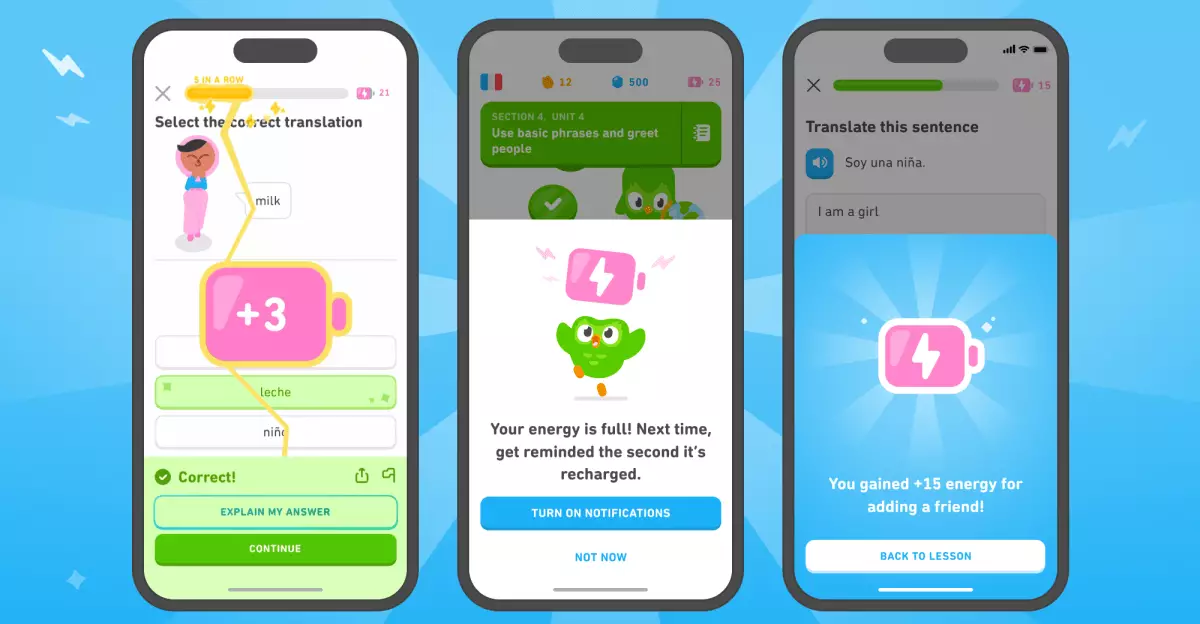In a bold move to enhance user engagement and motivation, Duolingo has announced a significant overhaul of its learning mechanics. Historically, the platform relied on a hearts system that penalized users for making mistakes during lessons. This punitive approach often discouraged learners, leading to frustration rather than growth. The new energy mechanic aims to foster a more supportive environment where errors are viewed as part of the learning process rather than setbacks. By shifting the focus from punitive measures to a system that rewards persistence and success, Duolingo is playing a crucial role in redefining digital language learning.
The Essence of Energy Mechanics
With the introduction of the new energy system, Duolingo allows learners to invest energy units in exercises, promoting a more dynamic interaction with the app. Each lesson consumes one unit of energy, and making a mistake results in a corresponding energy deduction. However, there’s a silver lining: users can reclaim energy at a random rate for completing consecutive lessons correctly. This gamification aspect not only smooths the learning curve but also creates a sense of achievement that incentivizes continued participation. Rather than losing hearts and becoming discouraged after a single error, learners can now appreciate the value of their incremental improvements.
Quantifying Engagement: The Data Speaks
The early indicators of this transition are promising, suggesting a noticeable uptick in user engagement. Moses Wayne, a senior staff engineer at Duolingo, highlights that, thanks to the new energy structure, users are interacting with the platform significantly more than before. This data supports the idea that a less punitive framework can lead to increased motivation, which is vital in language acquisition. Learning a new language is inherently challenging, and by removing demotivating factors, Duolingo’s new system is likely to empower users to push through obstacles instead of giving up.
A Level Playing Field for All Users
Another remarkable aspect of the energy system is its inclusivity. Previously, under the heart system, the possibility of failing within the initial lesson could be a demoralizing experience. The new format ensures that learners are not unfairly penalized right out of the gate. With 25 units of energy available, users have ample opportunity to make mistakes without the looming threat of running out of chances. This fundamental shift in attitude—where mistakes are not the end of the road but a learning opportunity—could profoundly impact the way individuals approach language learning, ultimately fostering a more resilient mindset.
Reimagining the Learning Experience
Duolingo’s commitment to transforming the educational experience runs deeper than just the introduction of energy mechanics. The company recently declared its intention to become “AI-first.” This shift indicates a broader vision of integrating artificial intelligence into their learning tools, offering personalized experiences that adapt to individual learning paces and styles. By blending advanced technology with educational methodologies, Duolingo is leveraging AI to create a more tailored and efficient language acquisition process, effectively doubling its language course offerings in the wake of this shift.
Aiming for a Mobile Future
As part of this transition, the app is initially rolling out the energy system on iOS devices, with plans for Android compatibility in the near future. This phased rollout exemplifies the careful approach Duolingo is taking to ensure users adapt smoothly to the new mechanics. The separation of user experiences across platforms during this transition may lead to discrepancies for users who practice on multiple devices, but it also serves as an opportunity for the company to collect user feedback and refine their methods before a wider release.
By embracing a gamified experience that encourages continuous learning without heavy penalties, Duolingo is setting a new benchmark in the realm of language education. This shift—underpinned by user data and advanced technology—reflects a growing understanding of modern learners’ needs and the innovative approaches required to meet them.

